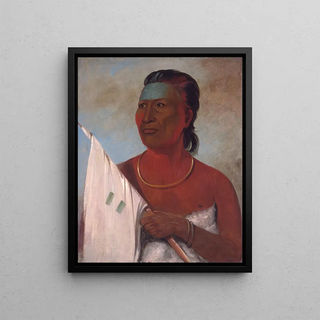Art print | Nh-pope, Black Hawk's soup advisor - George Catlin


View from behind

Frame (optional)
In the fascinating world of Native American art, the "Nh-pope, Black Hawk's soup advisor" by George Catlin stands as a poignant testament to the culture and traditions of Indigenous peoples of America. This painting, created in the 19th century, evokes not only the beauty of faces and traditional costumes but also the depth of the stories that accompany them. Catlin, as an artist and ethnographer, captured the very essence of his subjects, offering the world a valuable glimpse into the life and beliefs of Indian nations. The art print of this work allows you to relive that era and appreciate the richness of a heritage often overlooked.
Style and uniqueness of the work
Catlin's work is distinguished by its realistic approach and ability to convey genuine emotion. The choice of colors, textures, and meticulous details demonstrates attentive and respectful observation of the subjects. In "Nh-pope, Black Hawk's soup advisor," each element, from the enigmatic smile of the character to the delicate ornaments of his costume, is carefully rendered, revealing an intimacy that invites contemplation. The backgrounds are often minimal, allowing the viewer to focus on the main subject while creating a narrative space that enriches the interpretation of the piece. Catlin does not merely depict; he tells a story, that of a vibrant culture worth celebrating and preserving.
The artist and his influence
George Catlin, born in 1796, was one of the first artists to dedicate his career to representing Indigenous peoples of America. Traveling across the continent, he created a vast collection of works that testify to the diversity and richness of Native American cultures. His commitment to preserving these traditions, during a time of social and political upheaval, makes him an iconic figure in art history. Catlin not only influenced his contemporaries but his work continues to inspire generations of artists and historians. By highlighting the faces and stories of Indigenous peoples, he has contributed to

Matte finish

View from behind

Frame (optional)
In the fascinating world of Native American art, the "Nh-pope, Black Hawk's soup advisor" by George Catlin stands as a poignant testament to the culture and traditions of Indigenous peoples of America. This painting, created in the 19th century, evokes not only the beauty of faces and traditional costumes but also the depth of the stories that accompany them. Catlin, as an artist and ethnographer, captured the very essence of his subjects, offering the world a valuable glimpse into the life and beliefs of Indian nations. The art print of this work allows you to relive that era and appreciate the richness of a heritage often overlooked.
Style and uniqueness of the work
Catlin's work is distinguished by its realistic approach and ability to convey genuine emotion. The choice of colors, textures, and meticulous details demonstrates attentive and respectful observation of the subjects. In "Nh-pope, Black Hawk's soup advisor," each element, from the enigmatic smile of the character to the delicate ornaments of his costume, is carefully rendered, revealing an intimacy that invites contemplation. The backgrounds are often minimal, allowing the viewer to focus on the main subject while creating a narrative space that enriches the interpretation of the piece. Catlin does not merely depict; he tells a story, that of a vibrant culture worth celebrating and preserving.
The artist and his influence
George Catlin, born in 1796, was one of the first artists to dedicate his career to representing Indigenous peoples of America. Traveling across the continent, he created a vast collection of works that testify to the diversity and richness of Native American cultures. His commitment to preserving these traditions, during a time of social and political upheaval, makes him an iconic figure in art history. Catlin not only influenced his contemporaries but his work continues to inspire generations of artists and historians. By highlighting the faces and stories of Indigenous peoples, he has contributed to






